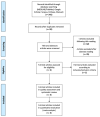Bond Strength of Self-Adhesive Flowable Composites and Glass Ionomer Cements to Primary Teeth: A Systematic Review and Meta-Analysis of In Vitro Studies
- PMID: 34772221
- PMCID: PMC8586968
- DOI: 10.3390/ma14216694
Bond Strength of Self-Adhesive Flowable Composites and Glass Ionomer Cements to Primary Teeth: A Systematic Review and Meta-Analysis of In Vitro Studies
Abstract
Background: Conventional composites are largely used in pediatric restorative dentistry and demonstrate successful clinical outcomes. However, the need for simplification of operative steps in young or uncooperative children demands reliable alternatives. Therefore, the aim of the present systematic review and meta-analysis was to evaluate the in vitro bond strength of glass ionomer cements (GICs) and self-adhesive flowable composites (SFCs) on deciduous teeth. Methods: A comprehensive literature search according to the PRISMA checklist was manually and electronically performed by two independent reviewers through the following databases: MEDLINE/PubMed, Google Scholar, Scopus, and Embase, to include in vitro studies comparing GICs and SFCs bond strength values of restorations on primary teeth. In addition, three groups of meta-analyses were conducted using random-effects models. Results: Three articles meeting the inclusion criteria were selected and subjected to both qualitative and quantitative assessment. No statistically significant difference was found between SFC versus GIC; however, both groups significantly differed with conventional flowable composites (CFs). Conclusions: Despite the absence of significant difference in bond strength values, SFCs may be considered a valid alternative to GICs in the restoration of deciduous teeth, although CFs proved better in vitro performances.
Keywords: bond strength; dental restorations; glass ionomer cements; primary teeth; self-adhesive flowable composites.
Conflict of interest statement
The authors declare no conflict of interest.
Figures





References
-
- Bowen R. Dental Filling Material Comprising Vinyl Silane Treated Fused Silica and a Binder Consisting of the Reaction Product of Bis Phenol and Glycidyl Acrylate. No. 3,066,112. US Patent. 1962 November 27;
-
- Donly K.J., García-Godoy F. The Use of Resin-based Composite in Children: An Update. Pediatr. Dent. 2015;37:136–143. - PubMed
-
- Van Meerbeek B., De Munck J., Yoshida Y., Inoue S., Vargas M., Vijay P., Van Landuyt K., Lambrechts P., Vanherle G. Buonocore memorial lecture. Adhesion to enamel and dentin:current status and future challenges. Oper. Dent. 2003;28:215–235. - PubMed
Publication types
LinkOut - more resources
Full Text Sources

